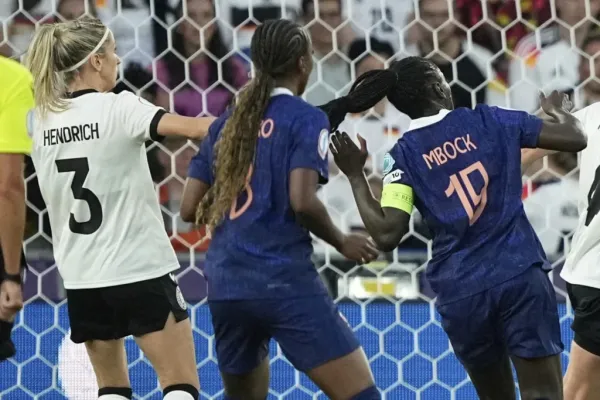
Two Hair-Pull Red Cards Rock Euro and Club Tournaments \ TezzBuzz \ Washington DC \ Mary Sidiqi \ Evening Edition \ Germany’s Kathrin Hendrich was sent off at the Women’s Euro for pulling France captain Griedge Mbock’s hair. The incident mirrors João Neves’ red card for hair-pulling in the Club World Cup final just six days earlier. France capitalized immediately, scoring from the resulting penalty to take the lead.
Quick Looks
- Germany’s Kathrin Hendrich received a red card for hair-pulling in the Euro quarterfinal.
- The foul occurred on France captain Griedge Mbock, spotted by VAR.
- Grace Geyoro scored the penalty, giving France an early 1-0 lead.
- The incident happened just six days after a similar red card.
- João Neves was ejected for pulling Marc Cucurella’s hair in the Club World Cup final.
Deep Look
The Women’s European Championship quarterfinal between Germany and France took an unexpected and controversial turn when German midfielder Kathrin Hendrich was shown a red card for pulling the hair of France’s captain Griedge Mbock. The incident, flagged by the Video Assistant Referee (VAR), occurred less than 13 minutes into the match and had an immediate impact on the game’s trajectory.
As a floated free kick entered the penalty area, Hendrich, under pressure and attempting to gain an advantage, resorted to an unusual defensive move — grabbing and pulling Mbock’s ponytail. Although the foul wasn’t immediately spotted by the on-field officials, VAR quickly intervened. Upon review, the referee issued a straight red card for violent conduct. Moments later, France capitalized on the situation with midfielder Grace Geyoro stepping up to the penalty spot and confidently converting, giving Les Bleues a 1-0 lead in the early minutes.
While red cards for violent conduct are not uncommon, the nature of Hendrich’s foul — hair-pulling — sparked discussion across social media and sports commentary platforms. This was no isolated event. The football world had just witnessed a similar scene less than a week earlier during the Club World Cup final. In that high-profile clash, Paris Saint-Germain’s João Neves was also ejected from play after pulling Chelsea defender Marc Cucurella’s hair during a heated moment near the end of the match. Chelsea went on to win the final 3-0, but the incident left a mark on what was otherwise a dominant performance.
These two incidents, occurring just six days apart, have ignited fresh debate about how such fouls should be interpreted and punished in professional football. While FIFA’s Laws of the Game already classify hair-pulling as potential violent conduct — punishable by a red card — it’s rarely enforced or even anticipated by players, coaches, and officials.
Hair-pulling is not commonly part of tactical analysis or training, and in the absence of specific discussions around it, players may underestimate its consequences. Yet, as recent events have proven, referees — backed by the scrutiny of VAR — are not hesitating to crack down on such unsportsmanlike conduct.
In the case of Hendrich, her early dismissal was especially damaging for Germany, as it not only left the team with ten players for nearly the entire match but also gave France a psychological edge. Playing with a numerical advantage from the start, France controlled possession, tempo, and pressure, ultimately dominating the game’s rhythm. The German side struggled to recover, and although they attempted to mount a defense, the early red card dictated much of their tactical retreat.
As football continues to evolve with the integration of technology like VAR, actions once considered borderline or hidden from view are now being re-evaluated. Slow-motion replays and multiple camera angles leave little room for ambiguity, increasing player accountability. These tools, while controversial at times, are ensuring that even unconventional fouls such as hair-pulling are no longer exempt from punishment.
Commentators and analysts have started to call for broader education among players about these types of violations. Some are even suggesting that football’s regulatory bodies might need to issue explicit statements or guidelines regarding hair- fouls, much like they do for dangerous tackles or handballs. There’s also debate over whether hair — particularly long hair tied in ponytails — should be considered part of the “shirt” or “body” in foul analysis, given that pulling it can impede a player’s movement.
In response to the recent headlines, some fans have humorously suggested that players should start wearing their hair shorter or tucked in to avoid giving opponents something to grab. Others argue that this places an unfair burden on the player with long hair, instead of addressing the behavior of the fouling player.
What’s clear is that hair-pulling has become an unexpected and bizarre flashpoint in recent football discourse. With both the Women’s European Championship and the Club World Cup under the spotlight, these incidents underscore how the modern game — with its emphasis on fairness, sportsmanship, and discipline — must continuously adapt to situations once thought to be too rare to regulate.
As football heads deeper into the tournament season, the Hendrich and Neves red cards serve as stark reminders: no matter how unconventional the foul may seem, there are no loopholes in the age of VAR. And pulling hair, whether out of frustration, strategy, or instinct, is now firmly on the list of unforgivable actions on the pitch.
More on Sports
-
UP: Kanwariyas assault CRPF jawan, three arrested

-
Mamata Banerjee is ‘worried’ for ‘brother’ SRK after he suffers muscle injury

-
“India Takes Its Global Commitments Seriously,” Says NITI Aayog At UN Forum

-
‘Who Lives If India Dies’: Tharoor Quotes Nehru, Defends National-First Stand Amid Congress Backlash

-
Eye Benefits: Top Superfoods to Improve Weak Eyesight and Boost Health Health Naturally
